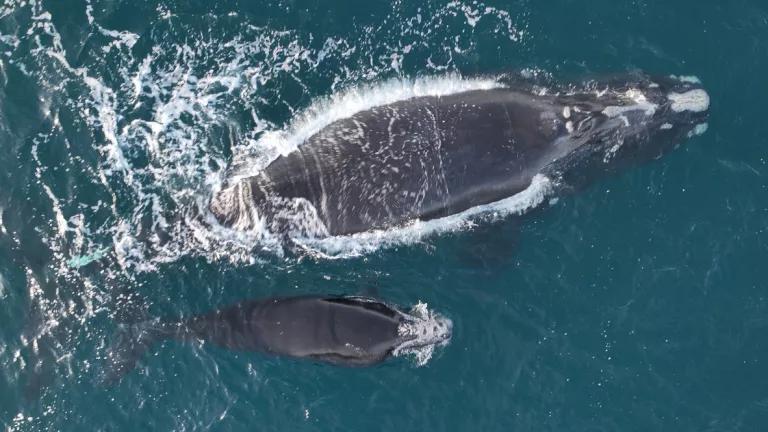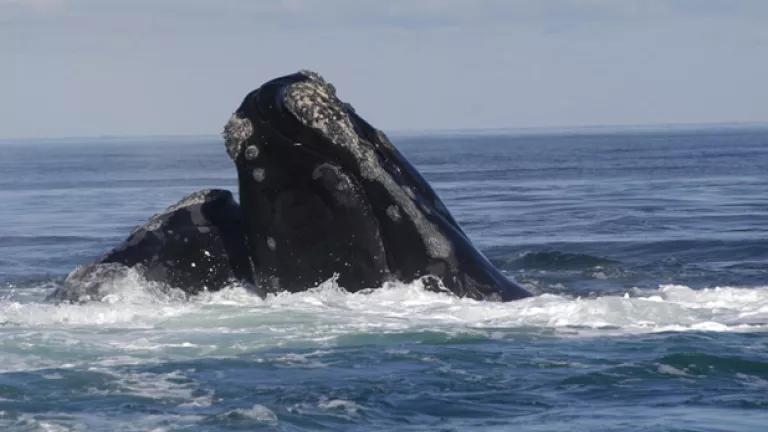Right Whale Calf Succumbs to Vessel Strike Injuries
The months-old calf of Juno has died from the injuries it sustained after being struck by a vessel in early January.

Juno and her calf are about 20 nautical miles off Sapelo Island on February 1, 2024. The propeller wounds are visible on the top of the calf’s head.
Georgia DNR/NOAA permit #24359
The body of Juno’s calf was found stranded on Cumberland Island National Seashore in Georgia on March 3rd. Experts examined the calf the following day and found that the multiple lacerations observed on the calf’s head caused by a vessel’s propeller when the calf was struck had penetrated into deep soft tissues and bone, leading to multiple sites of tissue death.
The birth of Juno’s calf was the cause of much excitement last November, as they were the first mother-calf pair sighted during the North Atlantic right whale calving season. But the joy was short lived. On January 3rd, members of the public found the young calf off Edisto, South Carolina, with several deep propeller wounds on its head, mouth, and left lip consistent with a vessel strike. After reviewing the case, NOAA Fisheries biologists made a preliminary determination that the wounds met the criteria of “serious injury,” meaning the calf is likely to die as a result.
The injured calf was monitored closely in the weeks after the event and there were some hopeful indications that the wounds were healing, and that the calf was successfully nursing. However, when the calf was sighted on February 26th, approximately 15 miles off St Andrew Sound, Georgia, its condition appeared to have deteriorated, and it was once again bleeding from its wounds. On March 2nd, Juno was seen off St. Augustine, Florida without her calf.

Juno's calf was seen bleeding from the previously documented vessel strike wounds.
Georgia DNR/NOAA permit #24359
Vessel strikes are one of the main causes of death for North Atlantic right whales, and mothers and their calves are particularly vulnerable because they spend more time at the surface and relatively close to shore. While there are regulations in place that require vessels to travel at speeds that are safer for whales (10 knots or less) on the right whale’s calving grounds in the winter, they currently only apply to vessels 65-feet and greater in length. But right whales are at risk of a lethal strike from vessels of any length if they are traveling faster than 10 knots. Indeed, examination of the propeller lacerations on Juno’s calf led to a preliminary estimate that the vessel involved in the incident was likely 35-57 feet in length.
One of the most tragic parts of the incident with Juno’s calf is that it could have been entirely avoided. NOAA Fisheries is in the process of finalizing an amended vessel speed rule, which requires vessels of the estimated size that hit the calf (and others in recent years) to slow down to 10 knots or less. The final rule was supposed to be issued last year, which could have helped protect Juno’s calf. But the amended rule experienced significant delays due to political and industry pressure, and only moved forward to federal review last week. Calls from environmental groups for the agency to issue emergency regulations to protect right whale mothers and their calves also went unheard by NOAA.
We are losing North Atlantic right whales at such a rate that there may be no reproductive females left in little more than a decade. When the conservation status of a species is this dire, every single individual counts. Mothers and calves are critically important to the recovery of the species, and are also the most easily harmed. Every effort must be made to protect them if the species is to survive.
But this problem goes beyond population numbers. The level of suffering experienced by individual animals—some only days old—as a result of being hit by vessels or entangled in fishing gear is unconscionable. The pain and distress experienced by Juno’s calf, and its mother, in the minutes, days, and weeks following the strike cannot and should not be set aside as we decide whether we value this species enough to change our behavior. To be willing to slow our vessels down to safe speeds in high risk areas, and to open our minds to forms of fishing that are safer for whales.
We urge the Biden Administration to expedite its federal review of the amended vessel speed rule and issue the new regulations as soon as possible to help the right whales we still have the ability to protect.




